OGWO-CH: Hybrid Opposition-Based Learning with Gray Wolf Optimization Based Clustering Technique in Wireless Sensor Networks
Abstract
:1. Introduction
- This paper has attempted to introduce an optimal energy-aware CH election methodology for energy-efficient routing in WSN using a novel “hybrid” technique.
- For the optimal selection of CH, the author formulated the fitness function with constraints such as energy consumption, minimal region among the nodes, the workload of elected CHs, and minimal delay during communication.
- Furthermore, the proposed OGWO technique collaborates with the opposition-based learning technique and generic GWO algorithm that dynamically trades off between the exploration and exploitation search processes during the CH electing process.
- Finally, the outcome of OGWO is compared with the existing algorithms such as LEACH, ABC, and GWO under several test cases, which validates the performance of the work.
2. Related Works
2.1. Classical Approaches
2.2. Metaheuristic Approaches
2.3. Hybrid Metaheuristic Approaches
2.4. Exact from the Literature
- (i)
- The capability of maintaining the trade-off in the search method is not sustained and fails to obtain the optimal solution within a minimal time.
- (ii)
- The energy trade-off guaranteed by the previous metaheuristic techniques is inadequate to improve or sustain the network lifespan.
3. Energy-Aware Cluster Head Selection Framework
3.1. Network Model
- (a)
- All sensor nodes in WSN are arbitrarily scattered among the 2D plane of the sensing environment that includes unique latitude and longitude location points.
- (b)
- Sensor nodes are energy constrained; once the sensors are deployed in the sensing environment, they are left unattended, since recharging them is unrealistic.
- (c)
- All the sensors are consistent and hold typical processing and transmission proficiencies; thus, they utilize the equal energy level for the transmission and processing of data bits.
- (d)
- Once the sensors are deployed in the sensing field, they are static concerning BS; all sensors in the network have equal opportunities to act as a regular node or CH.
- (e)
- All sensor nodes should detect data about their current circumstance and the same to be communicated to CH. Furthermore, the number of sensor nodes should be more prominent than the number of CHs.
- (f)
- The position of the BS is changeable according to the analysis of performance within the sensing region.
- (g)
- The transmission route between the sensor nodes and CHs is wireless, and its path is determined within the transmission region.
- (h)
- Finally, the sensor nodes can avail different communication power hierarchies concerning data transmission distance.
3.2. Energy Utilization Model
3.3. Distance Model
3.4. Objective Model
- (a)
- The residual energy of the CH
- (b)
- The distance among the sensor nodes
- (c)
- Distance between CH and BS
- (d)
- Node degree
- (e)
- Node centrality
4. Proposed Methodology
4.1. Solution Representation
4.2. Conventional Gray Wolf Optimization
- (a)
- Encircling
- (b)
- Hunting
- (c)
- Attack and search the prey
| Algorithm 1. Generic Gray Wolf Optimization. |
| 1: Set the parameters such as population size, A and C 2: Generate the random position of wolves within the search region 3: Compute the fitness of wolves 4: Determine the and dominant wolves 5: While () // Initially, 6: For 7: Modify the wolf position using Equation (19) 8: Compute the fitness of wolves 9: End for 10: Update the and dominant wolves 11: Increase value to 1 for every iteration (i.e., ) 12: End while |
4.3. Opposition-Based Learning Technique
| Algorithm 2. Oppositional-Based Learning Algorithm. |
| 1: Foremost, the algorithm initializes random solutions with the upper and lower boundary regions 2: Determine the opposite solutions: 2.1: 2.2: 2.3: 2.4: 2.5: 3: Sort the current and opposite solutions into minimum to maximum values. 4: Choose number of best candidate solutions from the recent and contrary solutions. 5: Update the control parameters for the quantified problem utilizing the OBL technique. 6: Generate the opposite solutions from current solutions using the jumping rate : 6.1: 6.2: 6.3: 6.4: ; 6.5: 6.6: ; 6.7: 6.8: 6.9: 7: Sort the solutions () and opposite solutions (opp) from minimum to maximum and choose the number of best candidate individuals from the recent and opposite solutions. 8: Replicate step 5 until the end criterion is satisfied. |
4.4. Proposed Algorithm
| Algorithm 3. Cluster Head Selection Using Proposed Technique. |
| 1: Generate arbitrary initial population ; 2: For 3: ; 4: For 5: ; 6: Ensure the search boundary; 7: End For 8: End For 9: Compute the fitness of all search agent 10: Pick the top best N solutions from to 11: Determine the first three best search agents of , and from 12: While 13: For 14: Modify the search agents’ position using Eq. (2) 15: Ensure the boundary limits of all search agents; 16: End for 17: For 18: If 19: ; 20: For 21: ; 22: Ensure the boundary limits; 23: End for 24: End if 25: End for 26: Compute the fitness of all search agents 27: Pick the top best N solutions from to 28: Update the three best search agents of , and from 29: Update the power exponent value 30: End while 30: Output: CHs from the network (optimal solution) |
4.5. Exploration and Exploitation Process of Proposed Algorithm
5. Experimentation and Result Analysis
5.1. Experimental Set-Up
5.2. Performance Evaluation Metrics
5.3. Result Analysis and Discussion
6. Conclusions
Author Contributions
Funding
Institutional Review Board Statement
Informed Consent Statement
Data Availability Statement
Acknowledgments
Conflicts of Interest
References
- Vajdi, A.; Zhang, G.; Wang, Y.; Wang, T. A New Self-Management Model for Large-Scale Event-Driven Wireless Sensor Networks. IEEE Sens. J. 2016, 16, 7537–7544. [Google Scholar] [CrossRef]
- Kaushik, S.; Indu, D.; Gupta, A. Grey Wolf Optimization Approach for Improving the Performance of Wireless Sensor Networks. Wirel. Pers. Commun. 2019, 106, 1429–1449. [Google Scholar] [CrossRef]
- Kevin, P.; Samarakoon, U.T. Performance analysis of wireless sensor network localization algorithms. Int. J. Comput. Netw. Appl. 2019, 6, 92–99. [Google Scholar] [CrossRef]
- Sekaran; Kaushik, R.; Rajakumar, K.; Dinesh, Y.; Rajkumar, T.; Latchoumi, P.; Kadry, S.; Lim, S. An energy-efficient cluster head selection in wireless sensor network using grey wolf optimization algorithm. TELKOMNIKA 2020, 18, 2822–2833. [Google Scholar] [CrossRef]
- Gherbi, C.; Aliouat, Z.; Benmohammed, M. An adaptive clustering approach to dynamic load balancing and energy efficiency in wireless sensor networks. Energy 2016, 114, 647–662. [Google Scholar] [CrossRef]
- Yuste-Delgado, A.J.; Cuevas-Martinez, J.C.; Trivino-Cabrera, A. EUDFC-Enhanced Unequal Distributed Type-2 Fuzzy Clus-tering Algorithm. IEEE Sens. J. 2019, 19, 4705–4716. [Google Scholar] [CrossRef]
- Sathiamoorthy, J.; Ramakrishnan, B.; Usha, M. A Three-Layered Peer-to-Peer Energy Efficient Protocol for Reliable and Secure Data Transmission in EAACK MANETs. J. Wirel. Pers. Commun. 2018, 102, 201–227. [Google Scholar]
- Sathiamoorthy, J.; Ramakrishnan, B.; Usha, M. A Trusted Waterfall Framework Based Peer to Peer Protocol for Reliable and Energy Efficient Data Transmission in MANETs. J. Wirel. Pers. Commun. 2018, 102, 95–124. [Google Scholar]
- Heinzelman, W.; Chandrakasan, A.; Balakrishnan, H. Energy-efficient communication protocol for wireless microsensor networks. In Proceedings of the Hawaii International Conference on System Sciences, Maui, HI, USA, 7 January 2002; p. 8020. [Google Scholar]
- Younis, O.; Fahmy, S. HEED: A hybrid, energy-efficient, distributed clustering approach for ad hoc sensor networks. IEEE Trans. Mob. Comput. 2004, 3, 366–379. [Google Scholar] [CrossRef]
- Kumar, N.; Sandeep; Bhutani, P.; Mishra, P. U-LEACH: A novel routing protocol for heterogeneous Wireless Sensor Networks. In Proceedings of the 2012 International Conference on Communication, Information & Computing Technology (ICCICT), Mumbai, India, 19–20 October 2012; pp. 1–4. [Google Scholar] [CrossRef]
- Yu, J.; Qi, Y.; Wang, G. An energy-driven unequal clustering protocol for heterogeneous wireless sensor networks. J. Control Theory Appl. 2011, 9, 133–139. [Google Scholar] [CrossRef]
- Bagci, H.; Yazici, A. An energy aware fuzzy approach to unequal clustering in wireless sensor net-works. Appl. Soft Comput. 2013, 13, 1741–1749. [Google Scholar] [CrossRef]
- Mazumdar, N.; Om, H. An energy efficient GA-based algorithm for clustering in wireless sensor networks. In Proceedings of the 2016 International Conference on Emerging Trends in Engineering, Technology and Science (ICETETS), Pudukkottai, India, 24–26 February 2016; pp. 1–7. [Google Scholar] [CrossRef]
- Karaboga, D.; Okdem, S.; Ozturk, C. Cluster based wireless sensor network routing using artificial bee colony algorithm. Wirel. Netw. 2012, 18, 847–860. [Google Scholar] [CrossRef]
- Agrawal, D.; Qureshi, M.H.W.; Pincha, P.; Srivastava, P.; Agarwal, S.; Tiwari, V.; Pandey, S. GWO-C: Grey wolf optimizer-based clustering scheme for WSNs. Int. J. Commun. Syst. 2020, 33, e4344. [Google Scholar] [CrossRef]
- Cai, X.; Geng, S.; Wu, D.; Wang, L.; Wu, Q. A unified heuristic bat algorithm to optimize the LEACH protocol. Concurr. Comput. Pr. Exp. 2019, 32, e5619. [Google Scholar] [CrossRef]
- Manshahia, M.S.; Dave, M.; Singh, S. Firefly algorithm based clustering technique for Wireless Sensor Networks. In Proceedings of the 2016 International Conference on Wireless Communications, Signal Processing and Networking (WiSPNET), Chennai, India, 23–25 March 2016; pp. 1273–1276. [Google Scholar] [CrossRef]
- Wang, J.; Cao, Y.; Li, B.; Kim, H.-J.; Lee, S. Particle swarm optimization based clustering algorithm with mobile sink for WSNs. Futur. Gener. Comput. Syst. 2017, 76, 452–457. [Google Scholar] [CrossRef]
- Vinodhini, R.; Gomathy, C. Fuzzy Based Unequal Clustering and Context-Aware Routing Based on Glow-Worm Swarm Optimization in Wireless Sensor Networks: Forest Fire Detection. Wirel. Pers. Commun. 2021, 118, 3501–3522. [Google Scholar] [CrossRef]
- Zhang, L.-G.; Xue, X.; Chu, S.-C. Improving K-Means with Harris Hawks Optimization Algorithm. In Advances in Intelligent Systems and Computing. Smart Innovation, Systems and Technologies; Springer: Singapore, 2022; pp. 95–104. [Google Scholar] [CrossRef]
- Altan, A.; Karasu, S.; Bekiros, S. Digital currency forecasting with chaotic meta-heuristic bio-inspired signal processing techniques. Chaos Soliton Fractal 2019, 126, 325–336. [Google Scholar] [CrossRef]
- Dowlatshahi; Bagher, M.; Nezamabadi-Pour, H. GGSA: A grouping gravitational search algorithm for data clustering. Eng. Appl. Artif. Intell. 2014, 36, 114–121. [Google Scholar] [CrossRef]
- Dowlatshahi, M.B.; Rafsanjani, M.K.; Gupta, B.B. An energy aware grouping memetic algorithm to schedule the sensing activity in WSNs-based IoT for smart cities. Appl. Soft Comput. 2021, 108, 107473. [Google Scholar] [CrossRef]
- Mehmood, A.; Mauri, J.L.; Noman, M.; Song, H. Improvement of the wireless sensor network lifetime using LEACH with vice-cluster head. Ad Hoc Sens. Wirel. Netw. 2015, 28, 1–17. [Google Scholar]
- Heinzelman, W.; Chandrakasan, A.; Balakrishnan, H. An application-specific protocol architecture for wireless microsensor networks. IEEE Trans. Wirel. Commun. 2002, 1, 660–670. [Google Scholar] [CrossRef]
- Singh, K. WSN LEACH based protocols: A structural analysis. In Proceedings of the 2015 international conference and workshop on computing and communication (IEMCON), Vancouver, BC, Canada, 15–17 October 2015; pp. 1–7. [Google Scholar]
- Abdellah; Ezzati; Benalla, S.A.I.D.; Hssane, A.B.; Hasnaoui, M.L. Advanced low energy adaptive clustering hierarchy. Int. J. Comput. Sci. Eng. 2010, 2, 2491–2497. [Google Scholar]
- Jerbi, W.; Guermazi, A.; Trabelsi, H. O-LEACH of routing protocol for Wireless Sensor Networks. In Proceedings of the 2016 13th International Conference on Computer Graphics, Imaging and Visualization, CGiV, Beni Mellal, Morocco, 29 March–1 April 2016; pp. 399–404. [Google Scholar]
- Huang, J.-H.; Zhao, Z.-M.; Yuan, Y.; Hong, Y.-D. Multi-factor and Distributed Clustering Routing Protocol in Wireless Sensor Networks. Wirel. Pers. Commun. 2017, 95, 2127–2142. [Google Scholar] [CrossRef]
- Aishwarya, M.; Kirthiga, S. Relay assisted cooperative communication for wireless sensor networks. In Proceedings of the 2018 Second International Conference on Advances in Electronics, Computers and Communications, ICAECC, Bangalore, India, 9–10 February 2018; pp. 1–6. [Google Scholar]
- Alnawafa; Emad; Marghescu, I. IMHT: Improved MHT-LEACH protocol for wireless sensor networks. In Proceedings of the 2017 8th International Conference on Information and Communication Systems (ICICS), Irbid, Jordan, 4–6 April 2017; pp. 246–251. [Google Scholar]
- Junping, H.; Yuhui, J.; Liang, D. A Time-based Cluster-Head Selection Algorithm for LEACH. In Proceedings of the 2008 IEEE Symposium on Computers and Communications, Marrakech, Morocco, 6–9 July 2008; pp. 1172–1176. [Google Scholar] [CrossRef]
- Amirthalingam, K. Improved leach: A modified leach for wireless sensor network. In Proceedings of the 2016 IEEE International Conference on Advances in Computer Applications (ICACA), Coimbatore, India, 24 October 2016; pp. 255–258. [Google Scholar]
- Daanoune, I.; Baghdad, A.; Balllouk, A. BRE-LEACH: A new approach to extend the lifetime of wireless sensor network. In Proceedings of the 2019 Third International Conference on Intelligent Computing in Data Sciences, ICDS, Marrakech, Morocco, 28–30 October 2019; pp. 1–6. [Google Scholar]
- Panchal, A.; Singh, R.K. EADCR: Energy Aware Distance Based Cluster Head Selection and Routing Protocol for Wireless Sensor Networks. J. Circuits Syst. Comput. 2020, 30, 21500638. [Google Scholar] [CrossRef]
- Gao, K.; He, Z.; Huang, Y.; Duan, P.; Suganthan, P. A survey on meta-heuristics for solving disassembly line balancing, planning and scheduling problems in remanufacturing. Swarm Evol. Comput. 2020, 57, 100719. [Google Scholar] [CrossRef]
- Al-Mekhlafi, Z.G.; Hanapi, Z.M.; Saleh, A.M.S. Firefly-inspired time synchronization mechanism for self-organizing ener-gyefficient wireless sensor networks: A survey. IEEE Access 2019, 7, 115229–115248. [Google Scholar] [CrossRef]
- Wang, T.; Zhang, G.; Yang, X.; Vajdi, A. Genetic algorithm for energy-efficient clustering and routing in wireless sensor net-works. J. Syst. Softw. 2018, 146, 196–214. [Google Scholar] [CrossRef]
- Mittal, N.; Singh, U.; Sohi, B.S. An energy-aware cluster-based stable protocol for wireless sensor networks. Neural Comput. Appl. 2018, 31, 7269–7286. [Google Scholar] [CrossRef]
- Yang, J.; Xu, M.; Zhao, W.; Xu, B. A Multipath Routing Protocol Based on Clustering and Ant Colony Optimization for Wireless Sensor Networks. Sensors 2010, 10, 4521–4540. [Google Scholar] [CrossRef]
- Ari, A.A.A.; Yenke, B.O.; Labraoui, N.; Damakoa, I.; Gueroui, A. A power efficient cluster-based routing algorithm for wireless sensor networks: Honeybees swarm intelligence based approach. J. Netw. Comput. Appl. 2016, 69, 77–97. [Google Scholar] [CrossRef]
- Sirdeshpande, N.; Udupi, V. Fractional lion optimization for cluster head-based routing protocol in wireless sensor network. J. Frankl. Inst. 2017, 354, 4457–4480. [Google Scholar] [CrossRef]
- Elhabyan, R.S.; Yagoub, M.C. Two-tier particle swarm optimization protocol for clustering and routing in wireless sensor network. J. Netw. Comput. Appl. 2015, 52, 116–128. [Google Scholar] [CrossRef]
- Rafsanjani, M.K.; Dowlatshahi, M.B. Using Gravitational Search Algorithm for Finding Near-optimal Base Station Location in Two-Tiered WSNs. Int. J. Mach. Learn. Comput. 2012, 377–380. [Google Scholar] [CrossRef]
- Kuchaki Rafsanjani, M.; Dowlatshahi, M.B.; Nezamabadi-Pour, H. Gravitational search algo-rithm to solve the K-of-N lifetime problem in two-tiered WSNs. J. Math. Inform. Sci. 2015, 10, 81–93. [Google Scholar]
- Oladimeji, M.O.; Turkey, M.; Dudley, S. HACH: Heuristic Algorithm for Clustering Hierarchy protocol in wireless sensor networks. Appl. Soft Comput. 2017, 55, 452–461. [Google Scholar] [CrossRef]
- Wang, J.; Gao, Y.; Liu, W.; Sangaiah, A.; Kim, H.-J. An Improved Routing Schema with Special Clustering Using PSO Algorithm for Heterogeneous Wireless Sensor Network. Sensors 2019, 19, 671. [Google Scholar] [CrossRef]
- Dwivedi; Kumar, A.; Sharma, A.K. I-FBECS: Improved fuzzy based energy efficient clustering using bioge-ography-based optimization in wireless sensor network. Trans. Emerg. Telecommun. Technol. 2021, 32, e4205. [Google Scholar] [CrossRef]
- Guleria, K.; Verma, A.K. An energy efficient load balanced cluster-based routing using ant colony optimization for WSN. Int. J. Pervasive Comput. Commun. 2018, 14, 233–246. [Google Scholar] [CrossRef]
- Guleria, K.; Verma, A.K. Meta-heuristic Ant Colony Optimization Based Unequal Clustering for Wireless Sensor Network. Wirel. Pers. Commun. 2019, 105, 891–911. [Google Scholar] [CrossRef]
- Rajakumar, R.; Dinesh, K.; Vengattaraman, T. An energy-efficient cluster formation in wireless sensor network using grey wolf optimisation. Int. J. Appl. Manag. Sci. 2021, 13, 124–140. [Google Scholar] [CrossRef]
- Mittal, N.; Singh, U.; Salgotra, R.; Sohi, B.S. A boolean spider monkey optimization based energy efficient clustering approach for WSNs. Wirel. Netw. 2017, 24, 2093–2109. [Google Scholar] [CrossRef]
- Sahoo, B.M.; Pandey, H.M.; Amgoth, T. GAPSO-H: A hybrid approach towards optimizing the cluster based routing in wireless sensor network. Swarm Evol. Comput. 2020, 60, 100772. [Google Scholar] [CrossRef]
- Mahesh, N.; Vijayachitra, S. DECSA: Hybrid dolphin echolocation and crow search optimization for cluster-based en-ergy-aware routing in WSN. Neural Comput. Appl. 2019, 31, 47–62. [Google Scholar] [CrossRef]
- Sengathir, J.; Rajesh, A.; Dhiman, G.; Vimal, S.; Yogaraja, C.; Viriyasitavat, W. A novel cluster head selection using Hybrid Artificial Bee Colony and Firefly Algorithm for network lifetime and stability in WSNs. Connect. Sci. 2021, 34, 387–408. [Google Scholar] [CrossRef]
- Dattatraya, K.N.; Rao, K.R. Hybrid based cluster head selection for maximizing network lifetime and energy efficiency in WSN. J. King Saud Univ. Comput. Inf. Sci. 2019, 34, 716–726. [Google Scholar] [CrossRef]
- Shankar, T.; Shanmugavel, S.; Rajesh, A. Hybrid HSA and PSO algorithm for energy efficient cluster head selection in wireless sensor networks. Swarm Evol. Comput. 2016, 30, 1–10. [Google Scholar] [CrossRef]
- Pitchaimanickam, B.; Murugaboopathi, G. A hybrid firefly algorithm with particle swarm optimization for energy efficient optimal cluster head selection in wireless sensor networks. Neural Comput. Appl. 2019, 32, 7709–7723. [Google Scholar] [CrossRef]
- Subramanian, P.; Sahayaraj, J.M.; Senthilkumar, S.; Alex, S. A Hybrid Grey Wolf and Crow Search Optimization Algorithm-Based Optimal Cluster Head Selection Scheme for Wireless Sensor Networks. Wirel. Pers. Commun. 2020, 113, 905–925. [Google Scholar] [CrossRef]
- Rao, P.C.S.; Jana, P.K.; Banka, H. A particle swarm optimization based energy efficient cluster head selection algorithm for wireless sensor networks. Wirel. Netw. 2016, 23, 2005–2020. [Google Scholar] [CrossRef]
- Mirjalili; Seyedali; Mirjalili, S.M.; Lewis, A. Grey wolf optimizer. Adv.Eng. Softw. 2014, 69, 46–61. [Google Scholar] [CrossRef]
- Tizhoosh, H.R. Opposition-based learning: A new scheme for machine intelligence. In Proceedings of the International Conference on Computational Intelligence for Modeling, Control and Automation, Vienna, Austria, 28–30 November 2005; pp. 695–701. [Google Scholar]
- Belge, E.; Altan, A.; Hacıoğlu, R. Metaheuristic Optimization-Based Path Planning and Tracking of Quad-copter for Payload Hold-Release Mission. Electronics 2022, 11, 1208. [Google Scholar] [CrossRef]
- Ahmad, T.; Haque, M.; Khan, A.M. An Energy-Efficient Cluster Head Selection Using Artificial bee’s colony optimization for wireless sensor networks. In Advances in Nature-Inspired Computing and Applications; Springer: Cham, Switzerland, 2019; pp. 189–203. [Google Scholar]
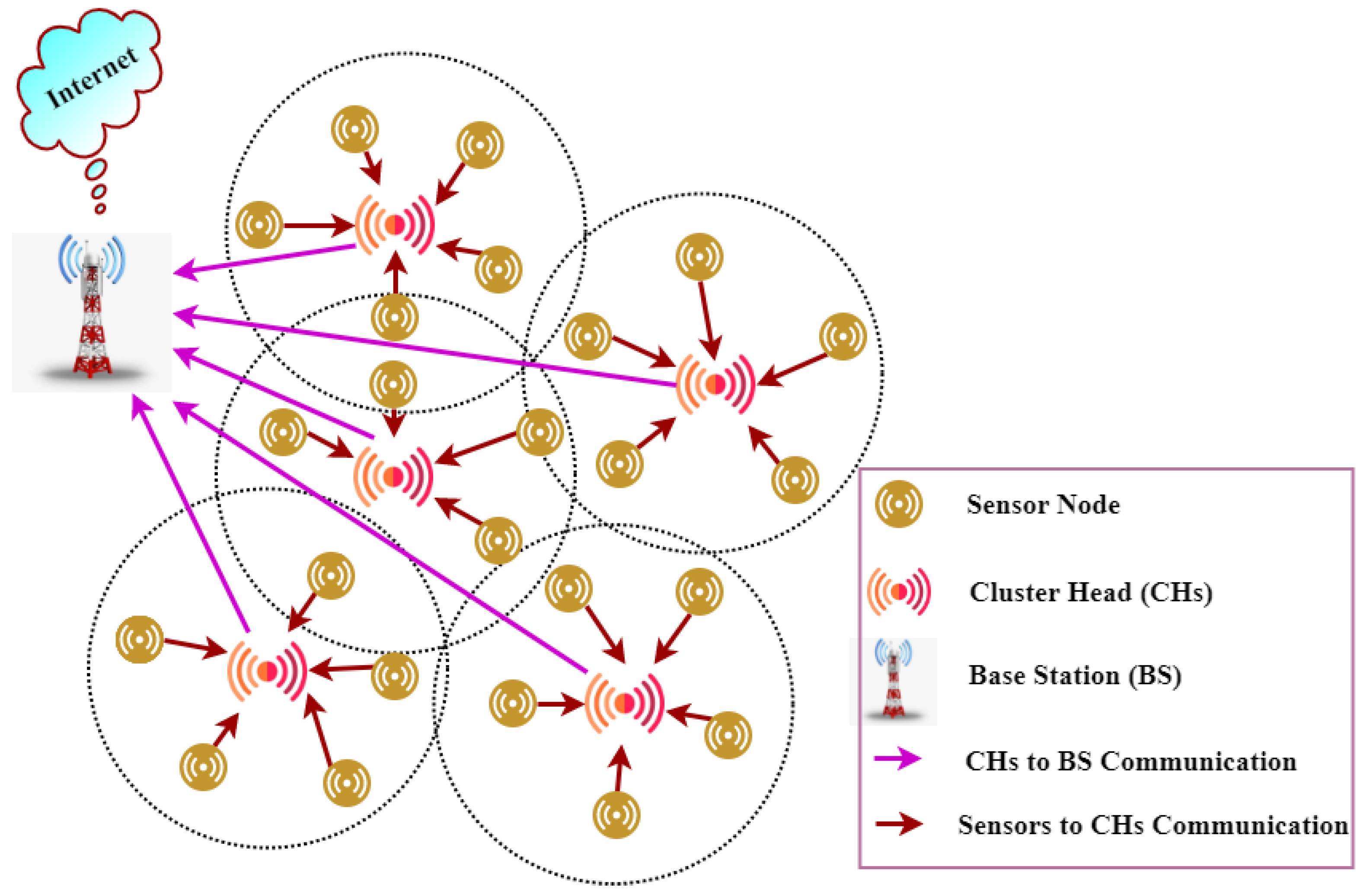


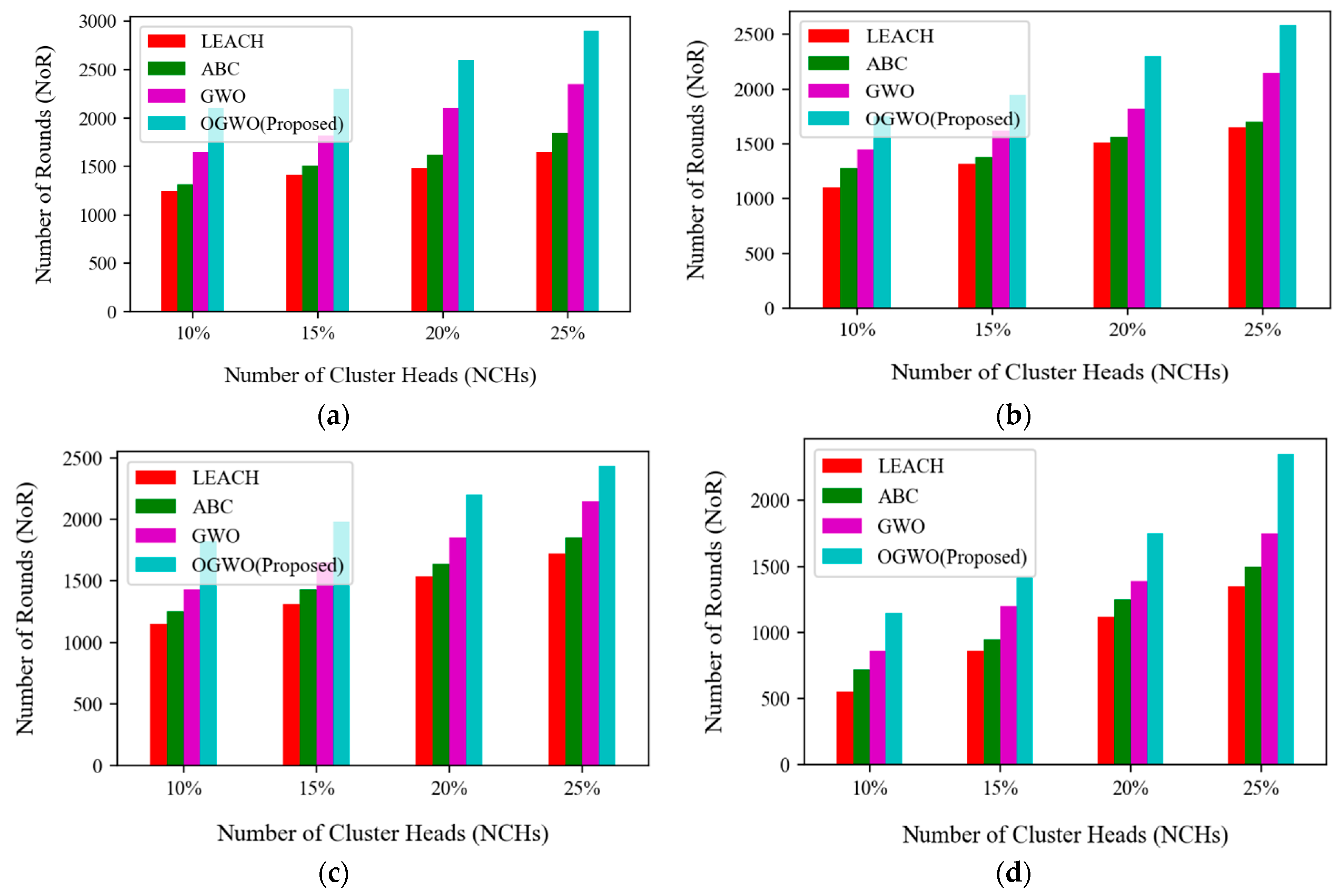
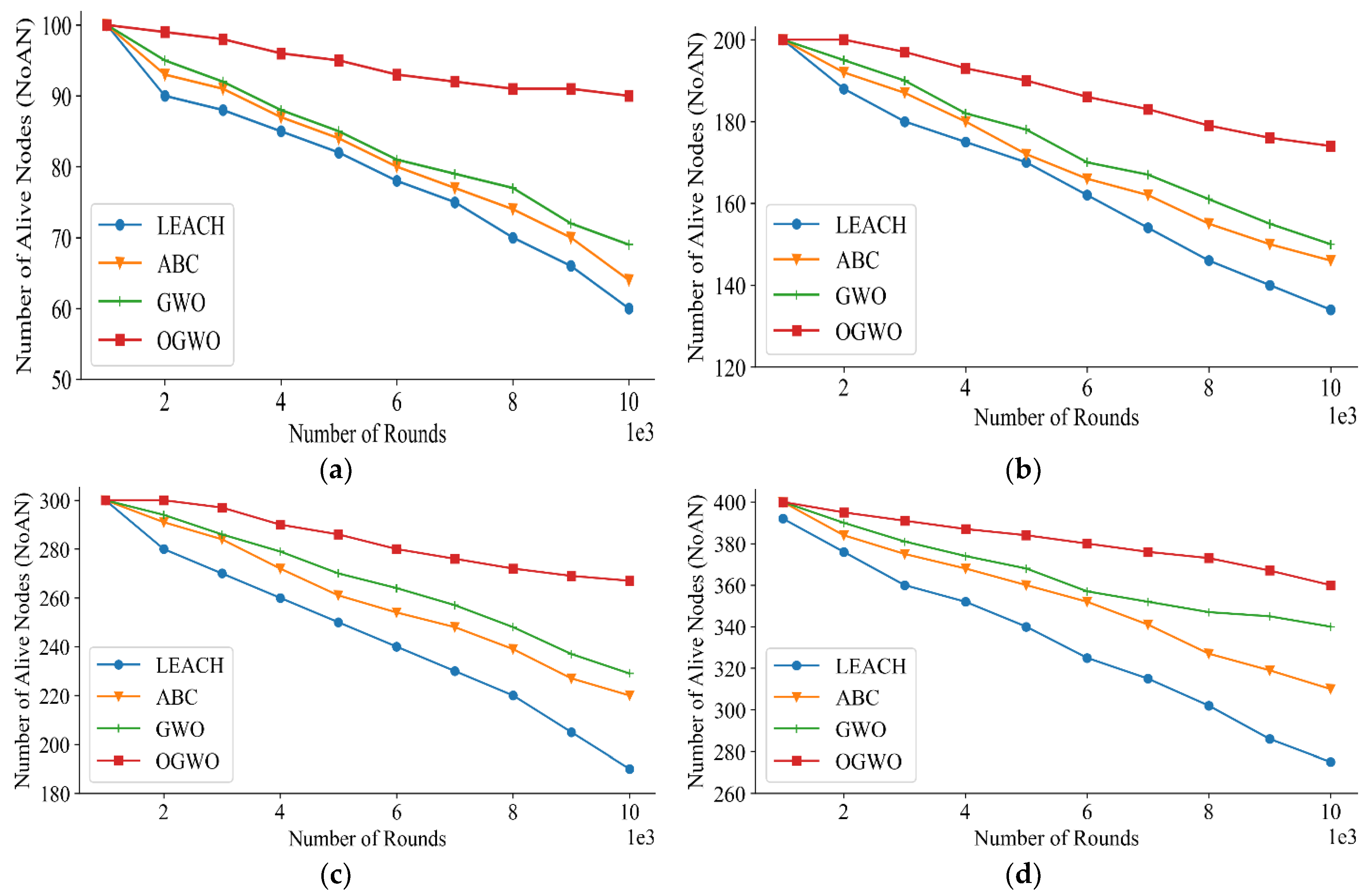

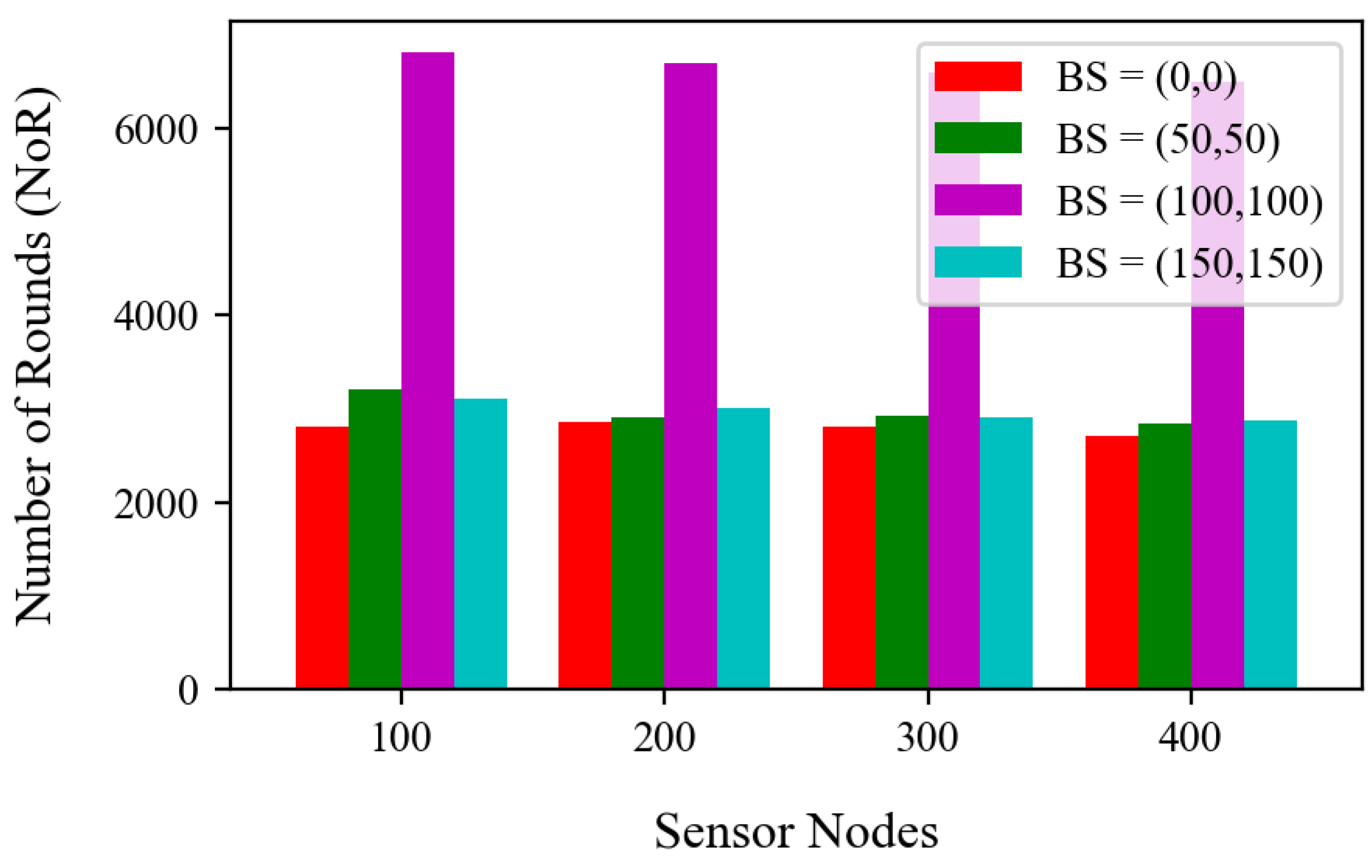
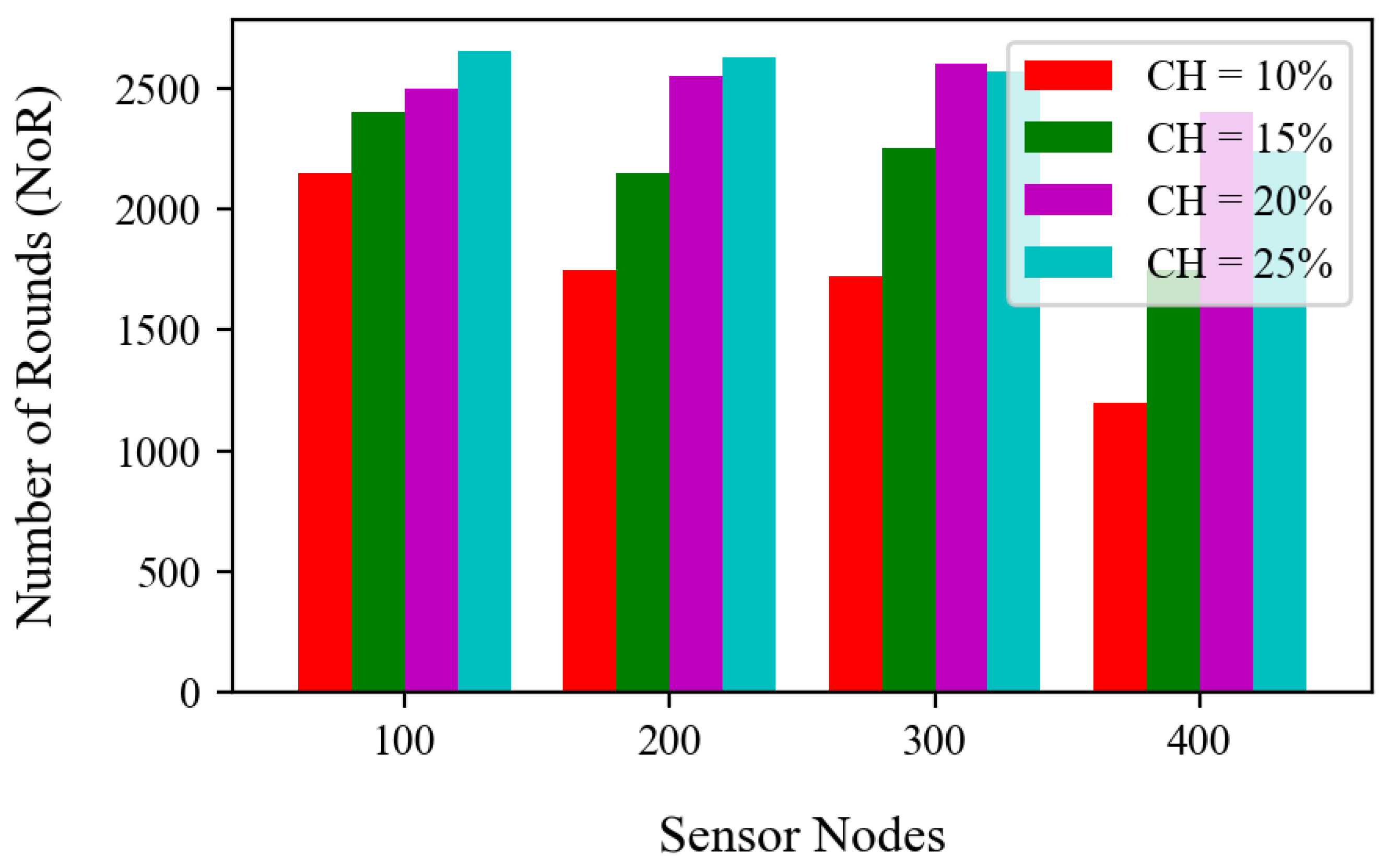
| Protocol | Objectives | Network Type | Parameters | Complexity | Limitations |
|---|---|---|---|---|---|
| VH-LEACH [25] |
| Homogenous |
| Yes |
|
| LEACH-F [27] |
| Homogeneous |
| Yes |
|
| A-LEACH [28] |
| Homogeneous |
| Yes |
|
| O-LEACH [29] |
| Homogeneous |
| Yes |
|
| MHT-LEACH [30] |
| Homogeneous |
| Yes |
|
| DMHT-LEACH [31] |
| Homogeneous |
| Yes |
|
| IMHT-LEACH [32] |
| Homogeneous |
| Yes |
|
| TB-LEACH [33] |
| Homogeneous |
| Yes |
|
| I-LEACH [34] |
| Homogeneous |
| No |
|
| BRE-LEACH [35] |
| Homogeneous |
| Yes |
|
| EADCR-LEACH [36] |
| Homogeneous |
| Yes |
|
| Algorithm | Year | Objectives | Mechanism | Metrics | Complexity | Simulation |
|---|---|---|---|---|---|---|
| ICWAQ [15] | 2012 | Reduce energy consumption |
|
| Yes | MATLAB |
| HACH [47] | 2017 | Network lifetime |
|
| Low | MATLAB |
| EC-PSO [48] | 2019 | Energy hole |
|
| Yes | MATLAB |
| I-FBECS [49] | 2021 | Network lifetime |
|
| Yes | MATLAB |
| LB-CR-ACO [50] | 2018 | Network lifetime |
|
| Yes | MATLAB |
| MHACO-UC [51] | 2019 | Reduce energy consumption |
|
| Yes | MATLAB |
| GWO-CH [52] | 2020 | Network lifetime |
|
| Low | MATLAB |
| SMO-CH [53] | 2018 | Load balancing Network lifetime |
|
| Yes | MATLAB |
| Parameter | Value |
|---|---|
| Deployment Area | |
| BS Location | (0,0) (50,50), (100,100), (150,150) |
| Number of Senor Nodes | 100 to 400 Nodes |
| Initial Node Energy | |
| Number of CHs (%) | |
| 100 m | |
| 30 m |
| Parameter | Value |
|---|---|
| Number of wolves | 100 |
| Maximum number of Iterations | 10 × 103 |
| Jumping rate (δ) | 0.4 |
| Coefficient parameter (c) | [2, 0] |
Publisher’s Note: MDPI stays neutral with regard to jurisdictional claims in published maps and institutional affiliations. |
© 2022 by the authors. Licensee MDPI, Basel, Switzerland. This article is an open access article distributed under the terms and conditions of the Creative Commons Attribution (CC BY) license (https://creativecommons.org/licenses/by/4.0/).
Share and Cite
Ramalingam, R.; Karunanidy, D.; Balakrishnan, A.; Rashid, M.; Dumka, A.; Afifi, A.; Alshamrani, S.S. OGWO-CH: Hybrid Opposition-Based Learning with Gray Wolf Optimization Based Clustering Technique in Wireless Sensor Networks. Electronics 2022, 11, 2593. https://doi.org/10.3390/electronics11162593
Ramalingam R, Karunanidy D, Balakrishnan A, Rashid M, Dumka A, Afifi A, Alshamrani SS. OGWO-CH: Hybrid Opposition-Based Learning with Gray Wolf Optimization Based Clustering Technique in Wireless Sensor Networks. Electronics. 2022; 11(16):2593. https://doi.org/10.3390/electronics11162593
Chicago/Turabian StyleRamalingam, Rajakumar, Dinesh Karunanidy, Aravind Balakrishnan, Mamoon Rashid, Ankur Dumka, Ashraf Afifi, and Sultan S. Alshamrani. 2022. "OGWO-CH: Hybrid Opposition-Based Learning with Gray Wolf Optimization Based Clustering Technique in Wireless Sensor Networks" Electronics 11, no. 16: 2593. https://doi.org/10.3390/electronics11162593
APA StyleRamalingam, R., Karunanidy, D., Balakrishnan, A., Rashid, M., Dumka, A., Afifi, A., & Alshamrani, S. S. (2022). OGWO-CH: Hybrid Opposition-Based Learning with Gray Wolf Optimization Based Clustering Technique in Wireless Sensor Networks. Electronics, 11(16), 2593. https://doi.org/10.3390/electronics11162593








